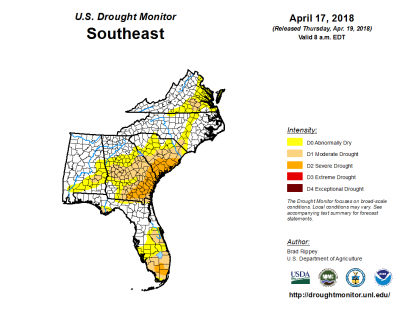Agriculture Secretary Brooke Rollins said on Tuesday that the Trump administration will announce a 'bridge payment' for farmers next week that is designed to provide short-term relief while longer trade…
Federal Reserve: Observations on the Ag Economy- April ’18
On Wednesday, the Federal Reserve Board released its April 2018 Beige Book update, a summary of commentary on current economic conditions by Federal Reserve District. The report included several observations pertaining to the U.S. agricultural economy.

* Sixth District- Atlanta– “Agriculture conditions across the District were mixed. Drought conditions improved in much of the District although light frosts in March affected some crops. Agricultural exporters indicated that the weaker dollar was having a favorable impact. On a year-over-year basis, prices paid to farmers in February were up for rice, beef, broilers, and eggs and down for corn, cotton, and soybeans.”

* Seventh District- Chicago– “Income prospects for the agricultural sector improved a bit during the reporting period, in spite of concerns about the impact of Chinese tariffs.
Corn and soybean prices moved higher (helped by weather concerns in Argentina) and allowed farmers to lock in modest profits for at least a portion of their crops this year.
#WASDE #Soybeans- For #Argentina, production is lowered 7.0 million tons to 40.0 million on reduced harvested area and yield, reflecting dry conditions during January through March. pic.twitter.com/m0DEkAWAH3
— Farm Policy (@FarmPolicy) April 10, 2018
“Moisture profiles for most of the District improved, though drought persisted in a portion of Iowa. Prospects for livestock operations dimmed some as cattle and hog prices declined and milk prices stayed low. Egg prices and prices for some dairy products did move up. Agricultural lenders continued to report a slowly rising number of financially stressed crop and livestock borrowers. Cash rents for cropland were lower than a year ago, but land values were stable overall.”
* Eighth District- St. Louis– “District agriculture conditions were unchanged from the previous reporting period and the same as a year earlier. District corn acreage for 2018 is expected to decrease 2 percent from last year. Planned soybean acreage is about the same as 2017 acreage. Cotton and rice acreages are expected to increase 2 percent and 16 percent, respectively, due to expectations of improved profitability. Overall, District acreage for the four major crops is expected to be roughly the same as in 2017.”
* Ninth District- Minneapolis– “District agricultural conditions were stable at low levels. Though drought conditions abated slightly since the last report, most of the Dakotas and portions of Montana remained dry heading into the spring planting season.”
* Tenth District- Kansas City– “In the Tenth District, farm income and credit conditions remained weak, and the short-term outlook for the agricultural sector has been influenced by 2018 crop production expectations and drought. Approximately half of winter wheat acres in Kansas and Oklahoma were rated as poor or very poor due to abnormally dry conditions.
Approximately 38% of winter #wheat production is w/i an area experiencing #drought, @USDA - OCE pic.twitter.com/KeteyF3oTL
— Farm Policy (@FarmPolicy) April 19, 2018
“Corn production was expected to remain unchanged or decline slightly in all District states. After very strong growth in 2017, production of soybeans was expected to remain relatively unchanged in most states, while cotton production in Oklahoma was forecasted to continue to expand due to higher prices relative to other crops. Lower production expectations for corn, soybeans and wheat supported slightly higher prices.
However, District contacts continued to express concerns about severe drought, cash flow shortages, decreasing liquidity among farm borrowers, high production expenses and trade uncertainty
* Eleventh District- Dallas– “Drought conditions plagued much of Texas, severely so in the Texas panhandle. Lack of soil moisture particularly affected winter wheat, and the crop was largely in poor to very poor condition. Pasture conditions were also negatively impacted, and some ranchers were moving cattle from grazing to feedlots earlier than usual.”
Approximately 24% of #cattle inventory is w/i an area experiencing #drought, @USDA - OCE pic.twitter.com/jzVKyASM9L
— Farm Policy (@FarmPolicy) April 19, 2018
“Texas will see an increase in cotton acres this year, according to contacts, driven by strong demand, relatively high cotton prices, and new provisions in the farm bill. Cattle prices declined over the reporting period, and milk prices remained low enough to start forcing some smaller dairies out of business. Trade issues continued to make agricultural producers and lenders nervous.”
* Twelfth District- San Francisco– “Activity in the agriculture sector was flat on balance. Wheat yields were up modestly across the District. Demand in the feedlot industry inched up on a year-over-year basis. Cattle profits were solid, though margins narrowed. Grain inventories remained elevated in the Mountain West, and sales contracts fell over the reporting period. Contacts noted that much of the grain industry continued to face prices below breakeven levels.”





